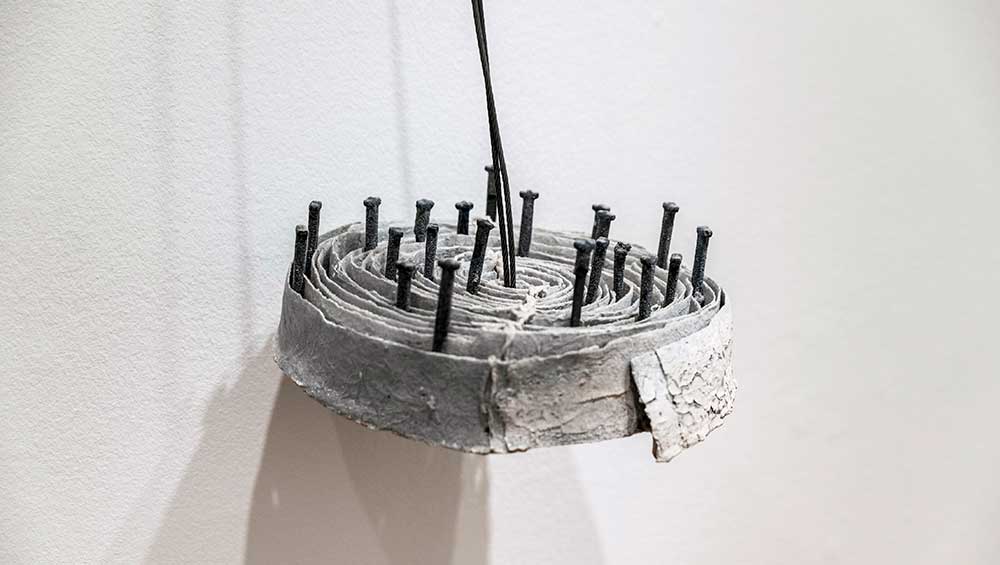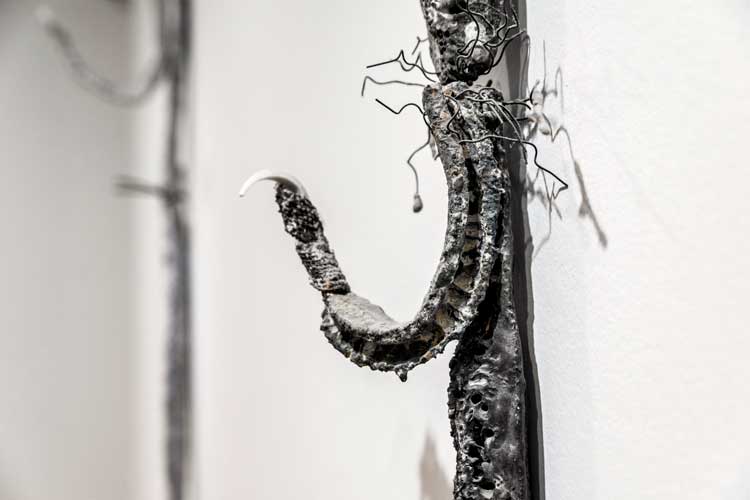
Gillian Lowndes. Hanging scroll, 1995. 145 x 27 cm. Collection of Ben Auld. Photo: Jo Hounsome Photography.
Holburne Museum, Bath
26 January – 21 April 2024
by ANNA McNAY
I didn’t know what to expect when I was commissioned to review this exhibition, as I hadn’t heard of Gillian Lowndes (1936-2010). Nevertheless, I was curious to find out more about this bricoleuse, and it turned out to be one of those treasures of a gallery visit, when I am met with something completely surprising, absorbing and inspiring, unsullied enough by criticism that I am free to let my mind loose to play with interpretations.
Hettie Judah got there before me, with the headline of her review in the Guardian labelling the exhibition “rude, punky and downright diabolical”.1 I am afraid I don’t agree. This bijou exhibition – one small room, painted white, with seven wall-mounted works, and a vitrine outside in the atrium, containing a further four, small-scale pieces – certainly stands in stark contrast to the general mood and style of the venue, but it is like entering a time capsule, a bubble separated from the wider museum by a thin veil of laboratory-bright light, and filled with broken, eroded, post-apocalyptic artefacts, all seemingly long since abandoned.

Gillian Lowndes, Hook Figure, 2008. 141 x 14 cm. Collection of Jenny Lowndes. Installation view, Gillian Lowndes: Radical Clay, Holburne Museum, Bath, 2024. Photo: Jo Hounsome Photography.
Lowndes’s Hook Figure series (1990s onwards, with two pieces from 2008 included here), for example, call to mind the flotsam and jetsam washed in with the tide and bleached by the sun – items you might pick up from the beach with curiosity, only to fling them away in disgust when the texture is not as expected. Indeed, seeking “to make work that looked fibrous in ceramics”, Lowndes came up with the idea of slicing up loofahs – along with cones, metal clips, electrical wires and plant roots – and dipping them in slip before firing them in a kiln. The process created forms of fossil. Likewise, Hanging Scroll (1995), which comprises multilayered, roughly cylindrical forms, interspersed with floorboard nails, seems cleaned and carefully preserved, but as if it might disintegrate were the nails to be removed.
-The-Sunday-Painter.jpg)
Gillian Lowndes, Scrollscape with Nail, 2003. © The Sunday Painter.
Lowndes described herself as a “materials-driven artist” and a “gatherer of impedimenta”,2 creating works that were “material-based objects, not pre-planned objects”. While loth to define her practice too restrictively – “I want to make what I want to make, I have an idea and I want to make an idea”3 – she concedes: “I’ve often called myself a ceramicist because I work in a kiln, but I’m probably a sculptor more than anything else.”4 As a student in the 1950s at the Central School of Arts and Crafts in London, Lowndes in fact transferred from the sculpture department – which she found “quite basic, easygoing [but] lacking in vision”5 – to the pottery department, where she discovered the limitless boundaries of working with clay. While, from the outset, Lowndes was concerned with investigations of material, process and transformation, using coiling, slabbing and press-moulding techniques, it was an 18-month stay in Nigeria, in the early 70s, with her partner, the fellow-potter Ian Auld, and their toddler, Ben, that opened her eyes to the possibilities of combining different – frequently “found” – materials in a single artefact. It was from this experience that the bricoleuse – or, as she described herself, “a general maker of materials” – was born.
-Photo-Dewi-Tannatt-Lloyd.jpg)
Gillian Lowndes, Almost Off the Wall, 2001. Collection of Jenny Lowndes. Photo: Dewi Tannatt Lloyd.
This exhibition focuses on Lowndes’s work from the 80s to the 00s, a period during which she experimented greatly and was influenced by the growing collection of African art, belonging to Auld (whom she eventually married in 1996). There is an element of arte povera to her practice, in her preference for basic, used, low-status materials, and she teetered perpetually on the edge of fine art and craft. This makes the objects on show here stand out not just from the museum’s rather more genteel collection, but also against the white-cube walls of the room chosen for the display. While each artefact might serve as a thought-provoking prompt for a piece of creative writing – especially the scrolls, which, like compacted wads of newsprint or manuscript, must hide myriad secrets and stories within – the effect of this assembly of pieces all together is especially striking. You could be walking through a lonely, post-nuclear landscape, with Scaffolding Cross (2008) a makeshift memorial, fashioned from the rubble, for those who didn’t survive, or you could be trespassing on a crime scene, with the implements of torture belonging to a serial killer all around. Almost Off the Wall (2001) – a crumple of smouldered metal, with a profusion of wires, exploding like snakes from the head of Medusa – might be an exploded bomb or a broken brain, in which the synapses have become disconnected. Is this what dementia looks like? Or, perhaps, inside the head of a mad scientist? More mundanely, it could just be a mangled electrical appliance, stashed at the back of the toolshed, along with the scrolls and the nails and the metal clips.
-The-Sunday-Painter.jpg)
Gillian Lowndes, Another Cup of Tea, 2005. © The Sunday Painter.
The four works in the vitrine are “table pieces” – ashen, as if recovered from the grate of an exhausted fire. Is Puffball Collage (c1990s) a mouse carcass? And Another Cup of Tea (2005) some humongous insect cadaver? Likely not, but who is to say? Is it wrong to look on and imagine? The friend with whom I visited the exhibition bemoaned the lack of explanatory texts (apart from a general introduction wall text, only titles and dates, and the description “mixed media”, are provided). Personally, I found this liberating, although I did later purchase the publication available in the shop. In it, Amanda Fielding, Lowndes’ biographer, describes her work as “rich with material transformations, transferred meanings, and unclear references to distant places and times, perhaps both past and future”.6 It encapsulates, for me, what happens when the manmade is left to battle nature and all her assaults. Although Lowndes’ work has been compared to that of Tony Cragg, David Mach, Bill Woodrow and Eva Hesse, I lean towards her own proclamation that: “I think in a way I have my own space. I think that I’m not approaching [ceramics] in the same way as anybody else I know.”7 Lowndes died of cancer, in 2010, aged 74. However one wishes to interpret and contextualise her work, I wholeheartedly agree with the Holburne’s claim that it is “one of the art world’s best kept secrets”.
References
1. Gillian Lowndes: Radical Clay review by Hettie Judah, the Guardian, 29 January 2024.
2. Gillian Lowndes by Amanda Fielding, York Museums Trust, 2013, page 13.
3. Op cit, page 43.
4. Op cit, page 97.
5. Op cit, page 21.
6. Op cit, page 75.
7. Op cit, page 11.